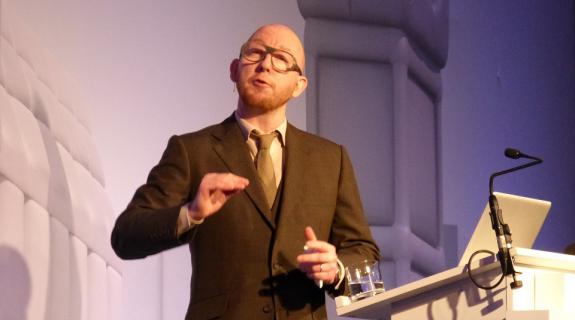When considering how best to build audiences, FreeState Creative Director Adam Scott takes inspiration from unlikely places: Louis Bunuel and Salvador Dali’s surrealist film “Un Chien Andalou;” Steve Wynn’s flamboyant Las Vegas casino, The Wynn; a 400-year-old metaphoric garden; a 40,000-year-old cave in Namibia where shamans once danced.
“When you mix sweet colors and sweet tastes with bitter sounds, this is incongruous. This might be poison,” Scott pronounced during his panel at PromaxBDA Europe 2014 in London on March 24.
That small bit of poison has power, Scott went on. It captures people’s attention and challenges them in good and necessary ways. “It gives me an excuse to say we should always be challenged. We should always use incongruity.”
Scott looks through three distinct creative lenses when he and his agency, FreeState, consider how to administer this “poison” to potential audiences: “surrealist,” “collaborative” and “outsider.” To elaborate on these concepts, he used a historical example paired with its modern marketing counterpart.
Scott first turned to Dali and Bunuel’s experimental film, “Un Chien Andalou,” to illustrate the power of the surrealist vision, one that disrupts the traditional view of what is beautiful and pleasing.
“Incongruity allows us to create something compelling, to create a deep empathy,” Scott said. “Inversion and disruption feel exciting. They are great ways to seize the imagination.”
A modern example of this sort of incongruity at work is Steve Wynn’s hyper-decorated Las Vegas casino, The Wynn, which assaults the senses with bright colors and lavish décor. While the hotel and casino seem almost garish, the concept works, according to Scott: “This is disruptive innovation. Disruptive design. I love the way [Wynn] challenges everything with his playful, disruptive surrealist lens.”
The concept clearly works from a business perspective as well: “The Wynn makes four times more money per square meter than any average casino,” said Scott.
The next lens Scott employs is that of the collaborator.
“While disruption causes you to engage, if you want to challenge people more than that, you have to go beyond step one where you want people to take part,” he said. “Obviously, there’s great risk in getting people to take part, to demand collaboration. What if they don’t want to take part? I’m going to look so stupid if that happens. But the rewards are high in building an audience around collaboration.”
Scott pulled his historical example from nearly 400 years ago, when Lord Cobham collaborated with designer William Kent on 40 acres of gardens that included the Temple of Modern Virtue, now a ruin. Besides being beautiful and bucolic, the gardens also were an anti-government statement.
“How incongruous to find a ruin in a place like that,” said Scott. “Underneath all of it is this temple of modern virtue saying that modern virtue is ruinous. This was incredibly risky storytelling.”
Fast forward, and Scott presents us with Sao Paolo, Brazil’s A Loja Vazia, or The Empty Shop. The shop starts each day empty, with bare mannequins staring out of clear glass windows. Donors bring clothes, and stylists dress the mannequins in the clothes to both sell them to the public and donate to charity. Over time, the store has collected 3.2 tons of clothes for people in need, and the concept has expanded around the world.
“What’s brilliant is the way it inspires your curiosity,” said Scott. “It’s transparent rather than opaque. It’s open, rather than closed. It’s absolutely inverted. One of the things that helps me connect with it is that it makes me want to take part, collaborate. It’s only a year and a half old, but it has a growing tribe of evangelists around it. There’s now seven other shops that have been built, and even an empty toy shop.
“Collaboration has legs: it allows the conversation to be more continuous and that’s very interesting. The collaborator’s lens challenges me to jump in,” he says.
The final lens is that of the outsider. To illustrate, Scott took the audience back 40,000 years, to a cave in ancient Namibia, where a shaman led a tribe in frenzied dance until they experienced a moment of transportation, “almost an altered state.”
“So much communication today is self-obsessed, derelict,” said Scott. “I love the outsider in this concept, the idea that there’s a continuous conversation that’s gone on for nearly 40,000 years.”
Today, people still go outside of themselves to join with others through music festivals, such as Coachella, or other gatherings, such as Burning Man. To illustrate, Scott showed a film by the Moment Factory, highlighting the moment at Coachella 2011 when Arcade Fire finished its concert in front of a large crowd, all singing the words and dancing while balloons fell among them.
“That was all about human connectivity and nothing about the rock and roll,” said Scott. “The outsider point of view liberates me. It allows me to go beyond, to innovate, to move people. It allows me to talk to clients and allows me to place those talks in a context that is much older and much bigger.”
Scott uses these three concepts at FreeState “to refresh our work. It allows us to always challenge everything. It allows us to wake up the clients, make them a little more excited, and that’s a good thing.”
“There is a magic ingredient that allows you to build relationships and audiences,” Scott concluded. “My advice would be: challenge me to collaborate with you, challenge me to remember you and maybe to poison me a little.”
Tags:













































__twocolumncontent.jpg)











